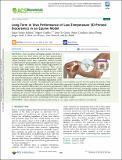| dc.contributor.author | Vindas Bolaños, Rafael | |
| dc.contributor.author | Castilho, Miguel | |
| dc.contributor.author | de Grauw, Janny | |
| dc.contributor.author | Cokelaere, Stefan M. | |
| dc.contributor.author | Plomp, Saskia | |
| dc.contributor.author | Groll, Jürgen | |
| dc.contributor.author | van Weeren, René | |
| dc.contributor.author | Gbureck, Uwe | |
| dc.contributor.author | Malda, Jos | |
| dc.date.accessioned | 2020-09-09T01:33:19Z | |
| dc.date.available | 2020-09-09T01:33:19Z | |
| dc.date.issued | 2020-01-31 | |
| dc.identifier.uri | http://hdl.handle.net/11056/18095 | |
| dc.description.abstract | Bone has great self-healing capacity, but above a certain critical size, bone defects will not heal spontaneously, requiring intervention to achieve full healing. Among the synthetic calcium phosphate (CaP) bone replacement materials, brushite (CaHPO4·2H2O)-based materials are of particular interest because of their degree of solubility and the related high potential to promote bone regeneration after dissolution. They can be produced tailor-made using modern three-dimensional (3D) printing technology. Although this type of implant has been widely tested in vitro, there are only limited in vivo data and less so in a relevant large animal model. In this study, material properties of a 3D-printed brushite-based scaffold are characterized, after which the material is tested by in vivo orthotopic implantation in the equine tuber coxae for 6 months. The implantation procedure was easy to perform and was well tolerated by the animals, which showed no detectable signs of discomfort. In vitro tests showed that compressive strength along the vertical axis of densely printed material was around 13 MPa, which was reduced to approximately 8 MPa in the cylindrical porous implant. In vivo, approximately 40% of the visible volume of the implants was degraded after 6 months and replaced by bone, showing the capacity to stimulate new bone formation. Histologically, ample bone ingrowth was observed. In contrast, empty defects were filled with fibrous tissue only, confirming the material’s osteoconductive capacity. It is concluded that this study provides proof that the 3D-printed brushite implants were able to promote new bone growth after 6 months’ implantation in a large animal model and that the new equine tuber coxae bone model that was used is a promising tool for bone regeneration studies. | es_ES |
| dc.description.abstract | El hueso tiene una gran capacidad de autocuración, pero por encima de un cierto tamaño crítico, los defectos óseos no se curan espontáneamente, por lo que es necesario intervenir para lograr una curación completa. Entre los materiales sintéticos de sustitución ósea de fosfato de calcio (CaP), los materiales a base de brusquitos (CaHPO4-2H2O) son de particular interés por su grado de solubilidad y el elevado potencial que presentan para promover la regeneración ósea después de la disolución. Pueden producirse a medida utilizando la moderna tecnología de impresión tridimensional (3D). Aunque este tipo de implante ha sido ampliamente probado in vitro, sólo hay datos limitados in vivo y menos en un modelo relevante de animal grande. En este estudio se caracterizan las propiedades del material de un andamiaje tridimensional impreso a base de grafito, tras lo cual el material se prueba mediante la implantación ortotópica in vivo en el tubérculo equino coxae durante 6 meses. El procedimiento de implantación fue fácil de realizar y fue bien tolerado por los animales, que no mostraron ningún signo detectable de molestia. Las pruebas in vitro demostraron que la resistencia a la compresión a lo largo del eje vertical del material densamente impreso era de alrededor de 13 MPa, que se redujo a aproximadamente 8 MPa en el implante cilíndrico poroso. En vivo, aproximadamente el 40% del volumen visible de los implantes se degradó después de 6 meses y fue reemplazado por hueso, lo que demuestra la capacidad de estimular la formación de nuevo hueso. Histológicamente, se observó un amplio crecimiento del hueso. En cambio, los defectos vacíos se llenaron sólo con tejido fibroso, confirmando la capacidad osteoconductiva del material. Se llega a la conclusión de que este estudio aporta pruebas de que los implantes de grafito tridimensional fueron capaces de promover el crecimiento de nuevo hueso después de 6 meses de implantación en un modelo de animal grande y que el nuevo modelo de hueso de tubérculo equino coxae que se utilizó es una herramienta prometedora para los estudios de regeneración ósea. | es_ES |
| dc.description.sponsorship | Universidad Nacional, Costa Rica | es_ES |
| dc.language.iso | eng | es_ES |
| dc.publisher | American Chemical Society | es_ES |
| dc.rights | Acceso abierto | es_ES |
| dc.rights | Attribution-NonCommercial-NoDerivatives 4.0 Internacional | * |
| dc.rights.uri | http://creativecommons.org/licenses/by-nc-nd/4.0/ | * |
| dc.source | ACS Biomater. Sci. Eng. 2020, 6, 3, 1681–1689 | es_ES |
| dc.subject | CABALLOS | es_ES |
| dc.subject | EQUINOS | es_ES |
| dc.subject | ENFERMEDADES OSEAS | es_ES |
| dc.subject | EQUINE MODELS | es_ES |
| dc.subject | CALCIO | es_ES |
| dc.subject | OSTEOCONDUCTION | es_ES |
| dc.subject | OSTEOINDUCTION | es_ES |
| dc.subject | CALCIUM PHOSPHATES | es_ES |
| dc.subject | REGENERACIÓN BIOLÓGICA | es_ES |
| dc.title | Long-term in vivo performance of low-temperature 3D-printed bioceramics in an equine model | es_ES |
| dc.type | http://purl.org/coar/resource_type/c_6501 | es_ES |
| dc.description.procedence | Escuela de Medicina Veterinaria | es_ES |
| dc.identifier.doi | https://doi.org/10.1021/acsbiomaterials.9b01819 | |


